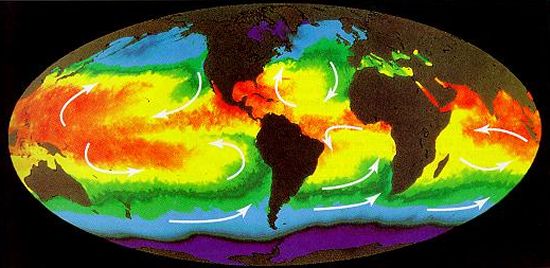|
||||||||||
|
|
||||||||||
|
||||||||||
|
|
||||||||||
Now your theory might have some merit if not for one simple fact. If what you say is true, then the wind should blow in the opposite direction of the Earth's rotation since the wind is "lagging behind." But in reality, the Earth rotates to the east and the winds over most of the planet blow to the east as well. These winds are called the Prevailing Westerlies since they blow out of the west and to the east. Furthermore, the Earth rotates fastest at the Equator, so according to your theory, this region is where the winds should blow the hardest. But as you can see below, the region along the Equator is referred to as the Doldrums because there is essentially no prevailing wind in this area.

So what does cause the wind to blow in a given direction? While the Earth's rotation does play a role, it is a somewhat indirect one. The primary factor that affects the formation of winds is differences in atmospheric pressure. As is true throughout nature, any fluid will try to move from a region of high pressure to a region of low pressure. The principal causes of these differences in pressure are related to the absorption of heat due to solar radiation.
Heating of the atmosphere will obviously vary with time of day and location on the Earth. For example, the mid-latitudes towards the Equator receive much more solar radiation than do high latitudes near the poles. As air is heated, it rises creating regions of lower pressure. Air from regions of higher pressure is then pulled into these low pressure zones creating wind. We feel this effect most forcefully during the winter months of the Northern Hemisphere. The warmer air of the mid-latitudes rises creating a low pressure, but the colder, denser air of the Arctic regions is at higher pressure. The pressure difference between these regions of warmer and cooler air pulls the jetstream further and further to the south bringing that bitterly cold Arctic wind over the central and eastern United States. This behavior occurs most often from December through February, often creating the sub-zero cold spells and major snowstorms that this time of year is known for. As Spring approaches and the North Pole tilts more towards the Sun, the differences in pressure due to the absorption of solar radiation become less pronounced and the jetstream stays further north over Canada.
An additional effect of solar radiation is its influence on large bodies of water, such as oceans or large lakes. These bodies of water also absorb solar radiation but release it at a much slower rate than does the atmosphere, or the land. On a local level, this behavior has the effect of creating breezes that tend to moderate the temperature extremes near shore. Land heats up and cools down more rapidly than does water. During daytime, the atmosphere over land becomes warmer thereby expanding and becoming less dense, and rises. This behavior creates a low pressure region over land that pulls in air from over water, where the pressure is higher. In the evening, temperatures over land drop more quickly than over water causing the breeze to operate in the reverse direction. Similar effects also operate on a global scale so that the distribution of water around the globe has a significant impact on the generation of wind. It is therefore not surprising that the direction of the prevailing winds illustrated above matches closely with the direction of the ocean currents shown below.

Nevertheless, you are correct in that the Earth's rotation does play some role in the formation of winds, and therefore has an indirect effect on the difference in east-to-west flight times. The rotation of the Earth creates what is known as the Coriolis force. We've already discussed why air moves from regions of high pressure to those of low pressure. If the Earth did not rotate, wind would blow in a straight line. But since the Earth is rotating beneath the wind, the path it follows becomes a curve. In the Northern Hemisphere, the Earth rotates counterclockwise so the wind is deflected to the right. The Southern Hemisphere rotates clockwise deflecting the wind to the left. Regardless, the Coriolis effect only influences the direction of the wind, not its speed.
So you can see that wind cannot be explained by something as simplistic as the rotation of the Earth. It is
instead a complex fluid dynamics problem that involves the Earth's rotation, imbalances in the heating of the
atmosphere caused by the Sun, and the absorption and radiation of heat by large bodies of water.
- answer by Joe Yoon, 30 March 2003
Related Topics:
Read More Articles:


|
Aircraft | Design | Ask Us | Shop | Search |

|
|
| About Us | Contact Us | Copyright © 1997- | |||
|
|
|||